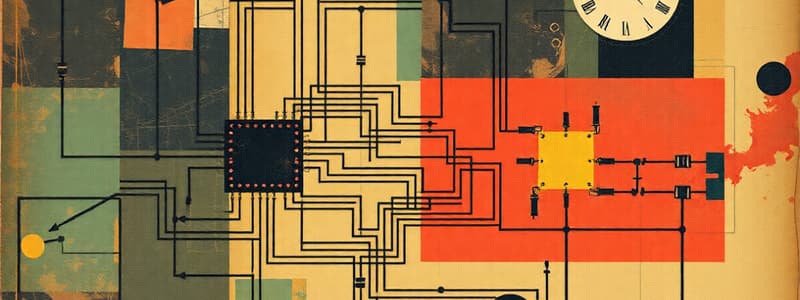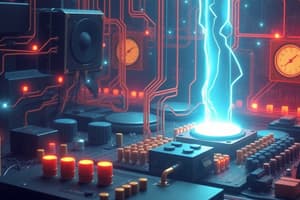Podcast
Questions and Answers
What does the cutoff frequency define in the frequency response of the amplifier?
What does the cutoff frequency define in the frequency response of the amplifier?
- The frequency at which the gain is halved (correct)
- The frequency with the highest output voltage
- The maximum frequency responding to the output
- The frequency at which the input signal is zero
What is the first step in the procedure for designing a common source FET amplifier?
What is the first step in the procedure for designing a common source FET amplifier?
- Set the input sine wave value using CRO
- Construct the circuit as shown in the circuit diagram (correct)
- Vary the frequency from the AFO
- Draw the graph of frequency response
Which formula is used to calculate gain in decibels (dB)?
Which formula is used to calculate gain in decibels (dB)?
- Gain = (V0 + Vin) / 2
- Gain = 20 log(V0/Vin) (correct)
- Gain = V0 - Vin
- Gain = Vin/V0
In the frequency response plot, what is typically shown on the X-axis?
In the frequency response plot, what is typically shown on the X-axis?
How do you determine the bandwidth of an amplifier?
How do you determine the bandwidth of an amplifier?
What component is primarily used to create a common source FET amplifier?
What component is primarily used to create a common source FET amplifier?
When varying frequency in the setup, what equipment is used to observe the output voltage?
When varying frequency in the setup, what equipment is used to observe the output voltage?
What is the significance of noting the output voltage during the procedure?
What is the significance of noting the output voltage during the procedure?
What is the primary aim of the experiment involving the Darlington pair?
What is the primary aim of the experiment involving the Darlington pair?
In the context of the frequency response of a current series amplifier, what is being found during the experiment?
In the context of the frequency response of a current series amplifier, what is being found during the experiment?
What does the 3dB line help to determine in the frequency response graph?
What does the 3dB line help to determine in the frequency response graph?
When constructing the current amplifier circuit, which component's value is primarily referenced from the datasheet?
When constructing the current amplifier circuit, which component's value is primarily referenced from the datasheet?
What type of wave form should the input signal be set to during the experiment?
What type of wave form should the input signal be set to during the experiment?
What mathematical formula is used to calculate the gain in dB for the amplifier?
What mathematical formula is used to calculate the gain in dB for the amplifier?
Which component is essential in forming the current series amplifier as per the provided diagram?
Which component is essential in forming the current series amplifier as per the provided diagram?
What is typically plotted on the X-axis of the frequency response graph?
What is typically plotted on the X-axis of the frequency response graph?
What is the formula to calculate the resonant frequency in a circuit?
What is the formula to calculate the resonant frequency in a circuit?
In a Hartley oscillator, how is the total inductance of the coils represented?
In a Hartley oscillator, how is the total inductance of the coils represented?
What voltage is set for VCC when making connections in the procedures described?
What voltage is set for VCC when making connections in the procedures described?
What is the relationship between the frequency of oscillations and the equivalent inductance and capacitance in a Hartley oscillator?
What is the relationship between the frequency of oscillations and the equivalent inductance and capacitance in a Hartley oscillator?
Which component is NOT mentioned as part of the Colpitts oscillator circuit diagram?
Which component is NOT mentioned as part of the Colpitts oscillator circuit diagram?
Which measurement is NOT part of the procedure for evaluating the oscillator output?
Which measurement is NOT part of the procedure for evaluating the oscillator output?
In a Colpitts oscillator, what is the primary purpose of the capacitors CIN and COUT?
In a Colpitts oscillator, what is the primary purpose of the capacitors CIN and COUT?
What type of configurations are typically used for the oscillator circuits discussed?
What type of configurations are typically used for the oscillator circuits discussed?
What is the relationship between frequency and time period for an oscillator?
What is the relationship between frequency and time period for an oscillator?
In a UJT relaxation oscillator, what does the variable $\eta$ represent?
In a UJT relaxation oscillator, what does the variable $\eta$ represent?
Which piece of equipment is essential for observing the output in a UJT relaxation oscillator?
Which piece of equipment is essential for observing the output in a UJT relaxation oscillator?
What is the expected relationship between experimental and theoretical output frequency in oscillators?
What is the expected relationship between experimental and theoretical output frequency in oscillators?
What is the primary function of a resistor in a UJT relaxation oscillator circuit?
What is the primary function of a resistor in a UJT relaxation oscillator circuit?
When varying the voltage $V_{EB}$, what will you observe?
When varying the voltage $V_{EB}$, what will you observe?
What is the primary purpose of the circuit diagram in the UJT relaxation oscillator experiment?
What is the primary purpose of the circuit diagram in the UJT relaxation oscillator experiment?
What would result from using a capacitor with a higher value in a UJT relaxation oscillator?
What would result from using a capacitor with a higher value in a UJT relaxation oscillator?
What determines the time constant T2 in the described circuit?
What determines the time constant T2 in the described circuit?
When will transistor Q2 turn ON?
When will transistor Q2 turn ON?
What is the expression for the total period T in the symmetrical circuit?
What is the expression for the total period T in the symmetrical circuit?
What values are chosen for the resistors R1 and R2 in practical applications?
What values are chosen for the resistors R1 and R2 in practical applications?
What is the maximum collector current (ICmax) specified in the circuit?
What is the maximum collector current (ICmax) specified in the circuit?
What is the theoretical frequency formula derived from the total period T?
What is the theoretical frequency formula derived from the total period T?
What is the role of capacitors C1 and C2 in the complementary push-pull amplifier circuit?
What is the role of capacitors C1 and C2 in the complementary push-pull amplifier circuit?
What is the saturation voltage at the base-emitter junction of the transistor indicated in the specifications?
What is the saturation voltage at the base-emitter junction of the transistor indicated in the specifications?
Flashcards are hidden until you start studying
Study Notes
Transistor as a Switch
- The experiment involves observing the input and output waveforms of a transistor acting as a switch
- The experiment uses a transistor as a switch, with input and output waveforms observed using a CRO (Cathode Ray Oscilloscope)
- The experiment measures and records the input and output voltage and time periods for different transistor types:
- Transistor
- FET
- MOSFET
- CMOS
Design of Common Source FET Amplifier
- The goal is to design a common source FET amplifier and plot its frequency response
- The experiment uses a FET (Field Effect Transistor) amplifier with a common source configuration
- The experiment measures and records the input and output voltage and time periods for different frequencies
- The experiment determines the lower and upper cut-off frequencies by observing the 3dB point on the frequency response graph
- The experiment calculates the bandwidth of the amplifier
Design of Current Amplifier using Darlington Pair
- The experiment involves designing a current amplifier using a Darlington pair and calculating its gain
- The experiment utilizes a Darlington pair configuration for current amplification
- The experiment measures and records the input and output voltage and time periods for different frequencies
- The experiment determines the lower and upper cut-off frequencies by observing the 3dB point on the frequency response graph
- The experiment calculates the bandwidth of the amplifier
Frequency Response of Current Series Amplifier
- The experiment involves constructing and analyzing the frequency response of a current series amplifier using a BJT (Bipolar Junction Transistor)
- The experiment implements a current series amplifier with and without feedback, and measures the frequency response
- The experiment determines the bandwidth of the amplifier with and without feedback
Design of Hartley/Colpitts Oscillator
- The experiment aims to design and test both Hartley and Colpitts oscillators, measuring their output frequencies
- The experiment uses a Colpitts oscillator circuit with an LC tank circuit, measuring the oscillations' frequency
- The experiment uses a Hartley oscillator circuit with an LC tank circuit, measuring the oscillations' frequency
- The experiment compares the theoretical and practical values of the oscillator's output frequency
Study the Characteristics of UJT and Design a Relaxation Oscillator using UJT
- The experiment involves studying the characteristics of a UJT (Unijunction Transistor) and designing a relaxation oscillator using it
- The experiment analyzes the input current (IE) and voltage (VEB) characteristics of a UJT, plotting them on a graph
- The experiment designs a relaxation oscillator using a UJT, measuring the various parameters such as the valley point (Vv), peak point (Vp), time period, and frequency
Design & Study of Astable Multivibrator
- The experiment aims to design and study an astable multivibrator circuit using two transistors (Q1 and Q2)
- The experiment analyses the output voltage waveforms at the collector and base of both transistors, measuring the frequency and time period
- The experiment compares theoretical and practical values of the astable's output frequency
Frequency Response Characteristics of Complementary Symmetry Push-Pull Amplifier
- The experiment aims to analyze the frequency response of a complementary symmetry push-pull amplifier
- The experiment uses a push-pull amplifier configuration with NPN and PNP transistors, measuring the amplifier's frequency response
- The experiment measures the input and output voltage, gain, and bandwidth of the amplifier for different frequencies
Studying That Suits You
Use AI to generate personalized quizzes and flashcards to suit your learning preferences.




